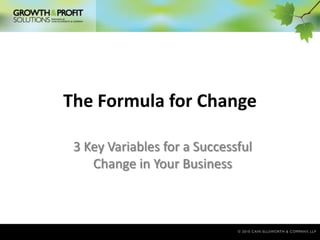
Formula For Change
- 1. The Formula for Change 3 Key Variables for a Successful Change in Your Business
- 2. C = D x V x P Where: C = Change D = Dissatisfaction V = Vision P = Plan
- 3. Dissatisfaction - This is the 'Why' or the motivational factor in the formula. Few among us like change. We fear and dislike it even more when the change is imposed on us. In most cases the level of dissatisfaction needed to support significant change efforts must be quite high. Organizations do not take on change unless there is a very strong reason to do so. That reason may be competitors becoming threats to your business, sales levels dropping or any number of painful issues. Key point: Where only a few people are feeling the pain – e.g., management – the change will be difficult. Unless the people who actually have to make the change – e.g., employees – feel the discomfort strongly, the change process will fail no matter how strong the Vision and Plan.
- 4. Vision - 'Dissatisfaction' pushes individuals to change but does not provide a direction. They know that they are not happy but don't know how to make it better. It pulls the individuals towards change by providing a direction. The Vision is the 'What' factor of the formula - how you would like the organization to be in the future. It should represent something that people really will like to be a part of and want to make happen. The contrast between the way things are now and the way they could be with change can generate enthusiasm to replace the fear and dissatisfaction. But without this clear sense of organizational direction and an inspiring future to work towards, your change effort will be hampered. People who do not know where they are going will, in their confusion,become another resisting force to be dealt with.Key point: If the Vision is not clear, misunderstandings will occur that will waste precious time, resources and energy.
- 5. Plan - This is the 'How' factor of the formula. A high level project plan with major activities, deliverables, and benefits can help increase the motivation to change. The amount of time, barriers, money, effort, training, communication and planning needed is commonly misjudged. Areview of past change experiences, both successful and unsuccessful, can help in gaining a better understanding of what is required to accomplish change within your organization. Key point: The three variables – dissatisfaction, vision and plan – must form a believable package that is supported by credible leadership. A vision and a plan without resources is just a fantasy. If your change formula stalls, the chances are one or more of the variables in this formula is the problem.
- 6. Calculating Change Potential EXAMPLE: D x V x P = Change Potential Dissatisfaction Vision Plan 5/10 5/10 4/10 = 100/1000 = 10% The change potential for the company in this example is quite low.
- 7. What can be done within your organization to increase the score of each variable to at least an 8? Key point: A change potential of at least 64% - e.g., two 8’s and a 10 – is indicative of an organization that will likely sustain a change process.
- 8. What’s Next? Calculate your potential for change. (Take your time and be honest. Often low dissatisfaction scores emanate from the “top” of the organization.) Discuss ideas for improving your score for each of the three variables. (Be sure to address, “What’s in it for me?”) Develop specific action plan priorities and make sure that you are a part of the implementation process.
- 9. Accredited Mindshop Facilitators: Mark J. Ellsworth, CPA mje@cainellsworth.com Matthew R. Heemstra, CPA mrh@cainellsworth.com Cain Ellsworth & Co., LLP 1008 Third Avenue Sheldon, IA 51201 (712) 324-4614 Follow us on our blog at http://www.cainellsworth.com/gps/blog/.